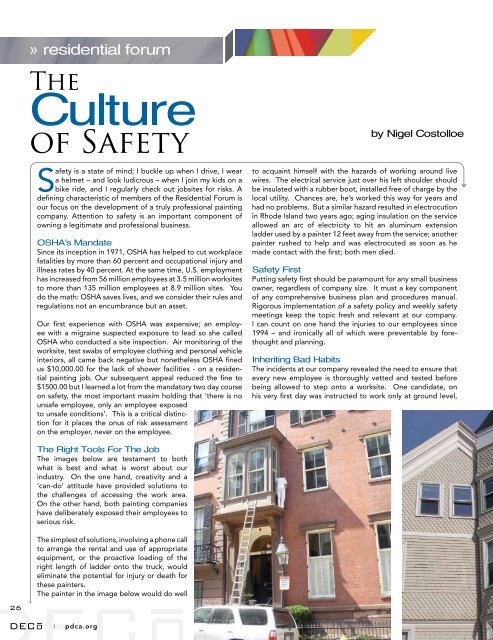n o v/d e c • 2 0 0 8 - Subscribe
n o v/d e c • 2 0 0 8 - Subscribe
n o v/d e c • 2 0 0 8 - Subscribe
You also want an ePaper? Increase the reach of your titles
YUMPU automatically turns print PDFs into web optimized ePapers that Google loves.
26<br />
» residential forum<br />
The<br />
Culture<br />
of Safety<br />
Safety is a state of mind; I buckle up when I drive, I wear<br />
a helmet – and look ludicrous – when I join my kids on a<br />
bike ride, and I regularly check out jobsites for risks. A<br />
defining characteristic of members of the Residential Forum is<br />
our focus on the development of a truly professional painting<br />
company. Attention to safety is an important component of<br />
owning a legitimate and professional business.<br />
OSHA’s Mandate<br />
Since its inception in 1971, OSHA has helped to cut workplace<br />
fatalities by more than 60 percent and occupational injury and<br />
illness rates by 40 percent. At the same time, U.S. employment<br />
has increased from 56 million employees at 3.5 million worksites<br />
to more than 135 million employees at 8.9 million sites. You<br />
do the math: OSHA saves lives, and we consider their rules and<br />
regulations not an encumbrance but an asset.<br />
Our first experience with OSHA was expensive; an employee<br />
with a migraine suspected exposure to lead so she called<br />
OSHA who conducted a site inspection. Air monitoring of the<br />
worksite, test swabs of employee clothing and personal vehicle<br />
interiors, all came back negative but nonetheless OSHA fined<br />
us $10,000.00 for the lack of shower facilities - on a residential<br />
painting job. Our subsequent appeal reduced the fine to<br />
$1500.00 but I learned a lot from the mandatory two day course<br />
on safety, the most important maxim holding that ‘there is no<br />
unsafe employee, only an employee exposed<br />
to unsafe conditions’. This is a critical distinction<br />
for it places the onus of risk assessment<br />
on the employer, never on the employee.<br />
The Right Tools For The Job<br />
The images below are testament to both<br />
what is best and what is worst about our<br />
industry. On the one hand, creativity and a<br />
‘can-do’ attitude have provided solutions to<br />
the challenges of accessing the work area.<br />
On the other hand, both painting companies<br />
have deliberately exposed their employees to<br />
serious risk.<br />
The simplest of solutions, involving a phone call<br />
to arrange the rental and use of appropriate<br />
equipment, or the proactive loading of the<br />
right length of ladder onto the truck, would<br />
eliminate the potential for injury or death for<br />
these painters.<br />
The painter in the image below would do well<br />
| pdca.org<br />
by Nigel Costolloe<br />
to acquaint himself with the hazards of working around live<br />
wires. The electrical service just over his left shoulder should<br />
be insulated with a rubber boot, installed free of charge by the<br />
local utility. Chances are, he’s worked this way for years and<br />
had no problems. But a similar hazard resulted in electrocution<br />
in Rhode Island two years ago; aging insulation on the service<br />
allowed an arc of electricity to hit an aluminum extension<br />
ladder used by a painter 12 feet away from the service; another<br />
painter rushed to help and was electrocuted as soon as he<br />
made contact with the first; both men died.<br />
Safety First<br />
Putting safety first should be paramount for any small business<br />
owner, regardless of company size. It must a key component<br />
of any comprehensive business plan and procedures manual.<br />
Rigorous implementation of a safety policy and weekly safety<br />
meetings keep the topic fresh and relevant at our company.<br />
I can count on one hand the injuries to our employees since<br />
1994 – and ironically all of which were preventable by forethought<br />
and planning.<br />
Inheriting Bad Habits<br />
The incidents at our company revealed the need to ensure that<br />
every new employee is thoroughly vetted and tested before<br />
being allowed to step onto a worksite. One candidate, on<br />
his very first day was instructed to work only at ground level,








